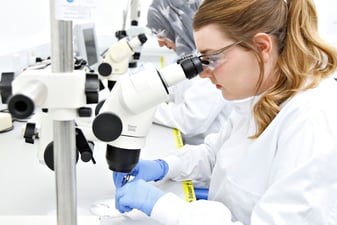Fresh human tissue residual to surgical and diagnostic procedures is often discarded as waste or processed and prepared in a fixed or frozen state for long-term storage as part of a biobank collection. Some stored tissue may be compatible with, and distributed for use in, future investigations and studies, but for many, the donated tissue can remain in storage unused for years. Estimates suggest that only fifteen percent of stored tissue samples are utilized in research studies.1 An alternative is to use the tissue at the time of recovery rather than process for storage. In its fresh unprocessed state residual tissue can be a precious commodity, particularly to researchers developing new medicines and treatments, where ex vivo fresh human tissue-based functional assays can provide valuable information on the safety and efficacy of a drug. Accessing human tissue for use in this type of research is dependent upon the goodwill of patients to donate residual tissue from their procedures and on the resources of a clinical site to carry out a patient’s wish to donate fresh tissue for immediate use. Here we discuss the importance of fresh human tissue to healthcare development and some of the options available to patients, medical professionals, and clinical sites to donate residual tissue to pharmaceutical research and contribute to this crucial area of research.
Why Do We Need Human Fresh Tissue Testing in Pharmaceutical Research?
Despite all the scientific and medical advances and improvements that have been made in our recent history, translation of new drugs from pre-clinical laboratory development to widespread clinical application can be a lengthy, problematic, and costly process.2 The reasons for poor translation are complex but are often associated with a lack of consistency and reproducibility between observations noted in cell- and animal-based models to those observed and documented in human populations.3 Ex vivo fresh human tissue testing can help researchers and pharmaceutical regulators better understand data from cell-based or in vivo animal models prior to clinical trials or use in human cohorts; enabling them to choose the most promising drug candidate to take forward, and to design or prioritize those patient cohorts most likely to benefit.4 Essentially, they focus the development process on the best translatable possibility, thereby reducing the time and costs associated with bringing poorly translatable treatments through the expensive in-human clinical phase of development.
Similarly, fresh human tissue testing approaches for use in direct clinical care, commonly referred to as precision medicine, are being developed. For some conditions, a patient may need to try several drugs or treatments to find the one most effective for them and their condition. This can be a slow and arduous process for patients. Ex vivo fresh human tissue assays utilizing a patient’s own tissue allow clinicians to choose the most effective treatment for an individual patient based on their tissue response in the assay i.e., personal to the patient. Thus, more effective treatments can be implemented sooner for patients by their clinician.
How Can Human Fresh Tissue Donation Improve Healthcare?
The use of fresh human tissue assays in scientific, medical, and pharmaceutical research can improve healthcare through discoveries in understanding risk, disease progression and mechanisms of action, improved and new medical procedures and through drug discovery and development. Below are two recent examples where donated fresh human tissue residual to surgical procedures and destined for clinical waste have significantly contributed to treatment development and clinical decision-making.
Case study 1
Targeted cancer therapies can cause severe diarrhea via various physiological mechanisms. Standard anti-diarrhoeal medication is often given to try and alleviate this side effect during treatment. A recent phase 1b clinical trial of a combination therapy for the treatment of breast cancer was paused due to the occurrence of severe diarrhea, even in the presence of a standard anti-diarrhea treatment. To address this complication and continue with the clinical trial, researchers investigated the mechanism of drug action in the gut to help understand why this side effect was occurring. Using fresh gut (colon) tissue - residual to a surgical procedure - in a functional assay demonstrating gut transport mechanisms, the researchers were able to show upregulation of chloride channels in the gut tissue as the root cause of the chronic diarrhea. As a result of this finding, it was concluded that an alternative anti-diarrhoeal medication specific to this mechanism was needed rather than the standard approach, thus, enabling the trial to continue.5
Case study 2
The daprivine vaginal ring (DPV-VR)- a self-initiated tool to prevent HIV infection in women -has been developed by researchers as a cost-effective approach for distribution in high HIV burden areas. Data from several clinical trials suggested that the ring could have a meaningful public health impact as part of a comprehensive HIV prevention portfolio.6 Following approval submission to the regulatory bodies, a request for more information with respect to effect on surrounding organs and tissue was made. To address this question, fresh human tissue-based approaches were utilized. Using freshly collected uterine tissue -from surgical discard – researchers were able to measure effects on muscle contractility. The data generated proved that the daprivine ring did not significantly affect uterine contraction. In addition to further safety checks in patients already using the ring, the data allowed the European Medical Agency and the World Health Organisation to provide a positive opinion on the rings use in HIV endemic areas.
These studies are only two of many such case studies that demonstrate the effectiveness of using fresh human tissue to address a medical question and improve clinical trial design or treatment implementation.
How can you contribute and get involved?
There are several ways to contribute to pharmaceutical research both as a patient and as a medical professional, many of which are incorporated within existing healthcare systems and procedures. For example, through clinical trials, volunteer registers and biobanks. For the donation and collection of fresh human tissue residual to surgery there are two main routes open to prospective participants and clinical sites.
Donation via a Biorepository or Biobank
A biorepository or biobank is a library where biospecimens (blood, tissue, urine etc.) are stored and made available for clinical or research purposes on a request basis. Traditionally, the term biorepository is used to refer to biospecimens of any source (animal, plant, microbe) whilst a biobank refers to those obtained from humans; however, the terms have become interchangeable in recent years.
Biorepositories have four main duties: collect; process; store; distribute. They have become a routine part of the global research structure with many large hospitals and research institutes now hosting their own or participating in larger multi-location biorepository systems. Usually closely aligned with both the pathology and surgical units within a hospital site to enable ease of access, biorepositories perform quality assured tasks that allow a patient to be ethically consented, tissue to be collected and processed quickly, clinical information to be collated, and monitoring of stored samples to ensure that donations are fit for purpose in subsequent research. Biorepository staff ensure that clinical and surgical colleagues can contribute to research with minimal disruption to their clinical duties and that patients have a route to contribute to multiple research programs – via a single consent process - if they so wish. The biorepository also acts as the main point of contact for research groups looking to obtain tissue samples for their research, usually operating a request and evaluation system to ensure that the research being undertaken is both ethical and of scientific or medical interest.
Dependent on their size and resourcing, some biorepositories will offer prospective collections of fresh and functional tissue suitable for the types of fresh human tissue research discussed above. Working with surgical, clinical, and pathology colleagues they operate biobank processes to collect fresh tissue samples from surgical or diagnostic procedures quickly, ensuring that the tissue is maintained in its fresh functional state, and coordinate the immediate transfer to the research laboratory – crucial to safeguarding the live function of the tissue in research assays.
For medical professionals and patients alike, the first port of call would be to check if your clinical site hosts a biorepository or biobank capable of prospective fresh human tissue collections. This information will be available on your clinical site website, through on-site literature or adverts or by asking your medical team (if you are a patient). A member of the biorepository team will be on hand to discuss all donation options undertaken at your site. If your site hosts a biorepository or biobank facility, ethically approved systems, and processes will be in place to help you easily donate tissue and contribute to ongoing research projects.
Donation via Industry and Healthcare Team Collaboration
If access to a biorepository is not feasible then participation in research can still be made via direct collaboration with pharmaceutical industry partners and associated research groups. Following the approval of a suitable ethical committee and hospital-associated Research and Development office, collaborations can be established directly between healthcare teams and research groups to operate tissue collection procedures and protocols. In this situation, the healthcare team and research group take on the responsibilities undertaken by a biorepository: the healthcare team assume responsibility for patient consent, tissue collection, and data collation; the research group facilitate all other aspects such as the provision of materials to the clinical site, the shipment and transfer of the donated tissue to the research laboratory, maintaining all regulatory and ethical permissions.
For patients wishing to participate and donate residual tissue, ask your healthcare team if they are participating in any ongoing studies with pharmaceutical research laboratories requiring fresh human tissue.
For medical professionals wishing to engage in collaboration contact your local R&D office or NHS Research in the first instance. Alternatively, look out for active research groups online, at conferences and meetings, or via direct email/flyer contact, who may be looking to partner. A quick discussion can establish if feasible to honor a patient's request to donate their tissue.
To find out more about partnering and collaborating with the REPROCELL Human Tissue Network to facilitate drug development research and improve patient options, please visit our webpage.
References
- Medicine Discovery Catapult, UseMyData. The Issue with Tissue: Recommendations for improving the use of human tissue samples (2020).
- Dowden H et al. Trends in clinical success rates and therapeutic focus. Nature reviews Drug discovery 18 (2019).
- Seyhan AA. Lost in translation: the valley of death across preclinical and clinical divide – identification of problems and overcoming obstacles. Transl Med Commun. 4;1 (2019).
- Bunton DC. Functional studies with human isolated tissues to better predict clinical safety and efficacy. RSC Drug Discovery Series. 41 (2015).
- Moisan A et al. Mechanistic investigations of diarrhea toxicity induced by Anti-HER2/3 combination therapy. Mol Cancer Ther. 17:7 (2018).
- Nel A et al. Safety, adherence, and HIV-1 seroconversion among women using the dapivirine vaginal ring (DREAM): an open-label, extension study. Lancet HIV 8;2 (2021).










